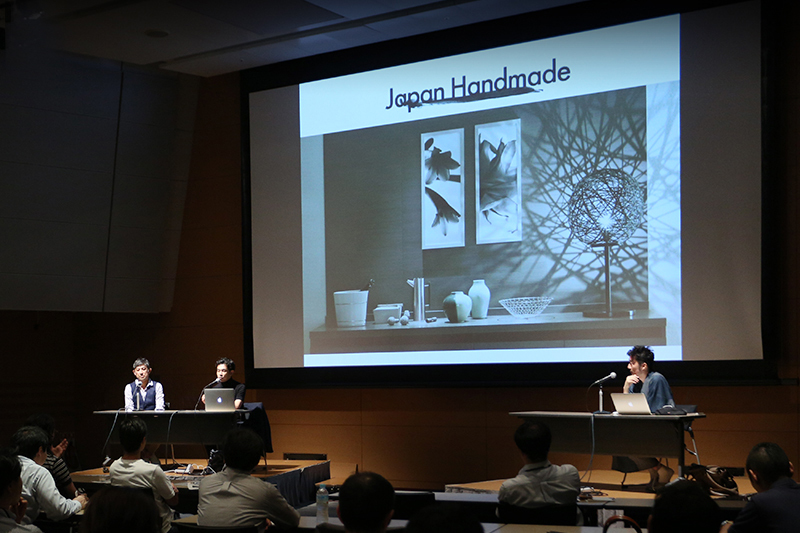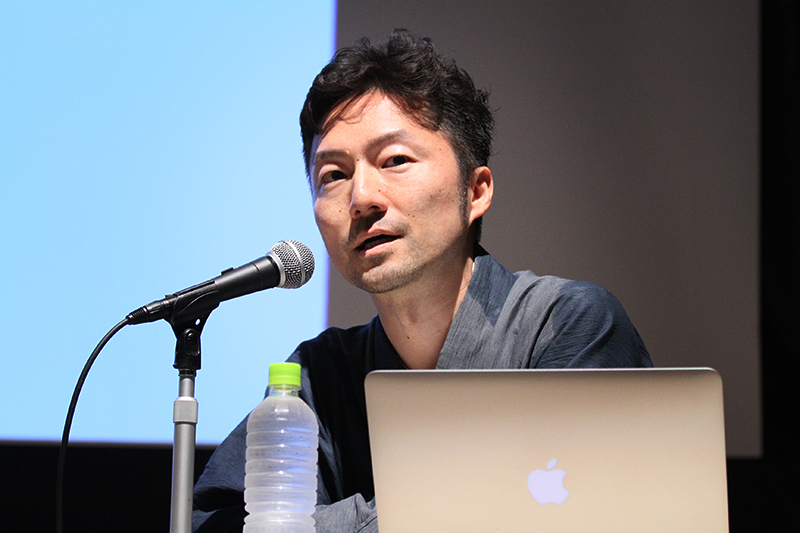After a decade of overseas assignments, Ryo Kagami of Dentsu Inc. Kyoto branch launched the "GO ON" project in 2012. This initiative, involving six traditional craft companies, aims to communicate the new value of Japanese traditional crafts. The new brand "Japan Handmade," born from this project, is now gaining attention, having been well-received in Milan and Paris. This time, we welcome Makoto Hosoo, the 12th-generation head of the Nishijin-ori weaving house "Hosoo," who has been advancing the project alongside Mr. Kagami, and Kotaro Okazaki of Sonar, who serves as Mr. Kagami's strategic advisor. Together, they will introduce their vision for the future of Japanese tradition and their plans to launch initiatives from Kyoto to the world.

(From left) Sonar's Kotaro Okazaki, Hosoo's Masataka Hosoo, Dentsu Inc.'s Ryo Kakamigi
Nishijin Textiles Merge with Cutting-Edge Technology
Kakami: GO ON is actively pursuing a Cool Japan approach by expanding overseas, inviting international visitors to Kyoto to experience its luxury community, and challenging collaborations with global corporations.
What do you think we should tackle next, Mr. Hosoo?
Hoso: One is integration with technology. Nishijin-ori is a complex fabric using 9,000 warp threads. We also have technology to control each individual thread by computer, weaving various types of threads into intricate patterns.
The world of textiles is evolving too, making it possible to weave in semiconductors and biosensors. As a result, for example, if car seats were made from fabric woven with biosensors, they could automatically stop the car if the driver dozes off.
However, what matters most is that Nishijin-ori has pursued beauty for 1,200 years. Therefore, the challenge lies not in showcasing technology upfront, but in how to subtly integrate it within the beauty of traditional craftsmanship.
Kakamigahara: You're also engaged in research, right?
Hoso: Yes. We plan to conduct research on the gers, the dwellings of Mongolian nomads, together with a team from a certain outdoor equipment manufacturer. Based on the approach that functionality lies behind beauty, we are considering whether we could build houses using Nishijin-ori.
Another theme I want to tackle is "kimono." Kimono are functional garments made by combining rectangular pieces of fabric. Similarly, the obi sash is constructed by folding a single piece of fabric into a three-dimensional structure, much like origami. I started research with a professor at MIT based on the idea that combining kimono with cutting-edge technology could create new value.
Okazaki: That's fascinating. For instance, using deep learning, we could teach it all sorts of rules at once—color variations, weaving techniques, and more. From there, AI could effortlessly create weaving patterns humans have never attempted.
A world beyond imagination could emerge from a realm entirely different from our experience. Rather than fearing this, GO ON's next stage is to understand that another universe exists—much like the mathematics behind beauty—and then consider what we will create.
Another crucial aspect is creating language. There are no words yet to describe what Hosoo-kun is doing. We need to systematize unique terms like "cool" or "kawaii" that foreigners can understand. Through this language, I believe foreigners won't just be amazed and leave; they'll start incorporating it into their own lives and businesses.
What's truly important to humanity lies within traditional crafts
Kakami: The members involved in GO ON have achieved results through pioneering efforts within Kyoto's traditional crafts. However, I imagine many traditional crafts across Japan face difficult circumstances. Do you have any advice?
Hoso: I feel it's essential to view things through the lens of having endured for 1,000 or even 3,000 years. What struck me as interesting is the ongoing plan for humans to reach Mars by 2030. Apparently, it takes half a year just to get there.
That means it becomes a way of life, not just travel. An American approach might involve mental coaches and fully equipped gyms, but perhaps the soothing touch of silk kimono fabric is better for calming the human spirit. After all, it has the proven track record of being worn by humans for millennia.
I believe the answer to what truly matters to humans might actually lie within traditional crafts.
Kakami: I want to see a world where traditional crafts like textiles and pottery are naturally present in everyday life again. Even in Kyoto restaurants, surprisingly few use Kyoto-style pottery.
Okazaki: To reach a future we can't yet imagine, we must first experiment, identify the obstacles, and systematically change them.
Why don't Kyoto restaurants use traditional craft tableware? I think tax issues play a role. If they were to acquire pieces like those used by tea ceremony masters, they'd face exorbitant taxes. So, to realize the world Kakami-kun envisions, we need to dismantle such systems.
But Kyoto should be good at making that happen. For example, if a restaurant belongs to a certain culinary association, they could offer tax deductions for the tea ware and tableware used there.
Kakami: Are there any points we should be mindful of as we move forward with GO ON?
Okazaki: That is, GO ON must not become a money-making machine. Culture is something built over time by the people who live there. So, rather than just chasing sales, we must give back to the people of Kyoto.
I'm an Edo native, but I was accepted as a junior member among the Gion danna-shu (patrons) and think I reached a position just below theirs. However, since I'm an outsider, I felt I needed to maintain some distance. And now I do keep my distance.
But Mr. Kagami, you seem to be clinging on pretty tightly (laughs).
Kakami: Yes, I'm too deeply immersed in Kyoto (laughs). Mr. Okazaki's business philosophy of "not making a killing" is truly Kyoto's aesthetic. I think Kyoto has a well-established system for maintaining a fair balance.
But sometimes those relationships become shackles that hinder innovation. As an outsider, I hope I can meddle and be of service in those areas.
Hoso: Incorporating outside cultures is crucial for preserving tradition. Since the environment is constantly changing, tradition must also adapt by embracing different elements.
In that regard, the French are skilled at building traditions. When I met the brand director of Dom Pérignon, he told me, "You have such great products, yet you're so bad at bringing them to the world."
Okazaki: Dom Pérignon champagne is remarkable for how strictly it adheres to its established form. Romanée-Conti commands such high prices—over ¥1.5 million per bottle—because its vineyard soil dates back to the Roman Empire. Yet wine from the adjacent plot, with nearly identical soil but a different parcel designation, sells for around ¥30,000 per bottle. This approach of placing value on "time" that can never be altered is something the French excel at.
Hoso: One of the GO ON members is the 16th-generation master of Asahi-yaki pottery. The clay they use is 100 years old. But for him, that's just normal, so he doesn't mention it. I only found out recently myself.
I imagine Kyoto holds countless values its own people don't even recognize. Despite having about 3,600 traditional craft companies, there's no established system for generating economic value from them. For instance, I fantasize about creating a festival in Kyoto centered around the concept of 1,000 years of time, attracting craft talent from around the world. And I want to increase the number of people carrying on traditional crafts, even if it's just one more person.
<END>
You can also read the interview here on AdTie!
Planning & Production: Dentsu Live Inc. Creative Unit Creative Room 2, Aki Kanahara









